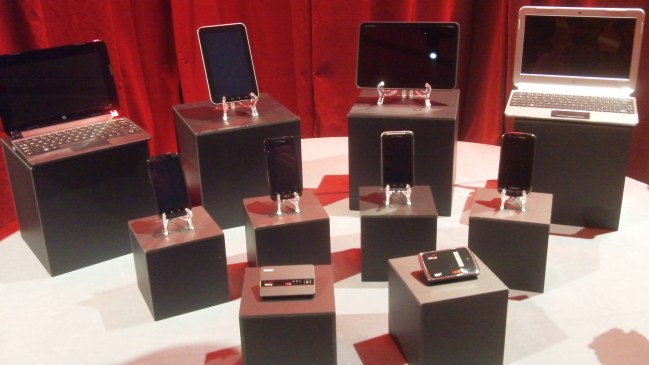
Surprising none, but impressing all, today at CES Verizon announced a new line of 4G products that the carrier will support. The 10 new 4G compatible products include two hotspots, two notebooks, two tablets and four new smartphones. All are set to debut later this year, and all will utilize Verizon’s 4G network, the largest 4G network in the country.
The devices announced are below. Pricing and release dates have not yet been confirmed:
–HTC Thunderbolt. The news about this phone debuting as a Verizon exclusive wasn’t much of a secret, but check out our hands on video of the newest HTC device. The Thunderbolt will feature integrated Skype mobile, a modified 1GHz Snapdragon processor, 4.3 inch WVGA display, Dolby surround sound, an 8 inch megapixel camera and HD video recording, and wireless DLNA capabilities.
–LG Revolution. LG’s newest smartphone will also double as a mobile hotspot, with the capability to share 4G connection with up to eight devices. It will support Android 2.2, feature video telephony support thanks to a front facing camera, and support HD playback and recording. Check out our hands on for a closer look.
–Droid Bionic 4G. This Android powered smartphone will feature Adobe Flash and HTML 5 support, a front facing VGA camera, an 8-megapixel camera, HDMI connectivity, a dual-core 1GHz processor, and 512 DDR2 RAM.
–Samsung 4G LTE Smartphone. Android 2.2 will come standard on Samsung’s newest smartphone, as will a 4.3 inch “Super AMOLED Plus” touch screen display. It will feature a 1GHz application processor, HTML5 browser, an 8-megapixel rear facing camera with LED flash, and a 1.3-megapixel front facing camera for video chat. Check out our hands on.
–Motorola XOOM. Motorola’s entry into the tablet wars will come with a 10.1-inch HD 4G LTE upgradable package powered by Android Honeycomb. It will support 1080p HD video, Flash, front and rear cameras, and can act as a hot spot for five devices.
–Samsung Galaxy. This 7-inch tablet features a TFT display with 1024 x 600 WSVGA resolution, Android 2.2, Flash, and a 1.2 GHz Cortex A8 Hummingbird application processor. Front and rear cameras will also be standard.
–Compaq cQ10-688nr Notebook. This notebook features a 10.1-inch diagonal anti-glare widescreen LED display, and be powered by Intel’s Atom N455 processor. It will also feature a battery with an 8.5 hour life.
–HP Pavilion dm1-3010nr. An 11.6-inch notebook with 1080p HD, Vision Technology from AMD, a battery with up to 10.5 hours of life.
–Novatel MiFi Intelligent Mobile Hotspot. A handheld hotspot capable of supporting five Wi-Fi enabled devices.
–Samsung 4G LTE Mobile Hotspot. A dual-mode device that can connect up to five Wi-Fi enabled devices.


